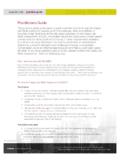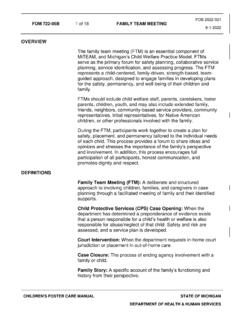Transcription of Interdisciplinary Team Care Facilitator Guide
1 Interdisciplinary Team CareFacilitator GuideCollaboratively developed byAcademicGeriatricResourceCenterD W. R FD~AGEF aculty Development toADVANCEGERIATRICEDUCATION2 Interdisciplinary Team care // TABLE OF CONTENTST able of ContentsIntroduction 3 Toolkit Contents 3 For Facilitators 4 Learning Goals 5 Learning Objectives
2 5 The IDT Approach To Inpatient care 6 Examples of IDT Members & Roles 7 IDT Organization 8 IDT Workflow 9 Goal Setting 9 Organizing Your IDT 10 Sample Standardized Form 10 Sample Discharge Checklist 10 Common Pitfalls 11 Utilizing The Video Clips 12 Patient Case #1 Mr Appleton 13 Patient Case #2 Mr James 15 Patient Case #3 Mr Wilkins 16 Patient Case #4 Mr Jimenez 17 References And Readings
3 183 Interdisciplinary Team care // INTRODUCTION & TOOLKIT CONTENTSI ntroductionResearch suggests that good Interdisciplinary team communication leads to improved patient and family outcomes (i e , high levels of patient and family satisfaction, symptom control, and reductions in length of stay and hospital costs) 1 The purpose of the Interdisciplinary team is to foster regular, structured and expert communica-tion among health professionals from different disciplines in order to establish, prioritize, and achieve patient treatment goals Interdisciplinary team communication is vital in an inpatient healthcare setting, as the complex nature and demands of the healthcare work en-vironment requires the expertise and knowledge of differing disciplines or specialists who can work together to solve multifaceted and complex patient care problems.
4 Interdisciplinary teamwork can improve the diagnostic and prognostic abili-ties of health professionals more than individual health professionals working IDT conference focuses on:1 Establishing the patient s progress toward medical goals2 Considering possible resolutions of any problems that could impede the patient s progress toward these goals3 Reassessing the goals previously established, if needed4 Monitoring and revising the treatment plan, as neededToolkit Contents1 Facilitation Guide a Guide with teaching points that can be used to facilitate a live ses-sion with your Facilitation Slides a PowerPoint presenta-tion that provides an overview of interdisci-plinary teaming and background for the exer-cise It should take 10-15 minutes to present 3 Four Team care Cases each consists of 1-2 short video clips with embedded pauses de-signed to stimulate group discussion around talking points provided FACILITATORSM ethodsThis exercise is designed for use in small preceptor
5 Groups led by a faculty tutor It is important to con-sider adequate time for the review and discus-sion of each patient study Completion of all four cases may require as long as 1 5 2 5 hours If only one hour is available, it is more appropriate to focus on one or two cases, allowing adequate time for learning, group discussion, and SuggestionsBegin by presenting the introductory PowerPoint to provide an overview of Interdisciplinary team care for your audience. Following the PowerPoint presentation, transition into the video case ex-amples Trigger questions to generate disucssion around each of these videos are provided later in this Guide DISCLAIMER.
6 During the exercise, clinicians often tend to discuss and try to solve medical is-sues, rather than focusing primarily on discharge planning goals Before starting the exercise, the tutor must understand and convey that each discipline brings different perspectives and goals, and it is his/her responsibility to keep the group focused on discharge planning Interdisciplinary Team care // FOR FACILITATORS5 LEARNING GOALSA lthough Interdisciplinary team meetings are used for multiple purposes, this tutorial will focus primarily on discharge planning (vs clinical problem solving; establish-ing a diagnosis, etc.)
7 As such, the following are the core learning goals for organizing and running an effective Interdisciplinary team meeting:1 Describe the Interdisciplinary team approach to inpatient care ;2 Understand and appreciate the roles of team members;3 Identify the purpose of the Interdisciplinary team; and4 Understand the importance of shared team leadershipLEARNING OBJECTIVES At the end of this module, the student should be able to:1 Define the concept of Interdisciplinary team care ;2 Describe the professional role and scope of practice of individual members of an Interdisciplinary health care team;3 Learn to structure an IDT Conference;4 Understand the goals of the IDT Conference;5 Identify ways to run an IDT Conference effectively.
8 And6 Discuss common pitfalls of the IDT ConferenceInterdisciplinary Team care // SLIDE ONE SLIDE ONE - LEARNING OBJECTIVESL earning Objectives Define Interdisciplinary team (IDT) care Identify roles of various IDT members Learn structure of IDT Conference Understand goals of IDT Conference Identify ways to run IDT Conference efficiently Discuss common pitfalls of IDT Conference6 THE IDT APPROACH TO INPATIENT CAREAn Interdisciplinary team consists of practitioners from different health professions, who have a shared patient population and common patient care goals, and have re-sponsibility for complementary tasks The team is actively interdependent, with an established means of ongo-ing communication (e g.)
9 A daily inpatient IDT meeting) among team members to ensure that various aspects of patients healthcare needs are integrated, aligned, ad-dressed, and met in a time-efficient Team care // SLIDES TWO, THREE & FOURSLIDE THREE - WHAT IS IDT care ?SLIDE FOUR - WHAT IS IDT care ?SLIDE TWO - WHAT IS IDT care ?What is IDT care ? Coordinated, collaborative, interdependent delivery of care Focuses on issues best addressed by Interdisciplinary teams Provided by a group of practitioners from various healthcare disciplines sharing common patient population & common patient care goals Relies on coordination, communication, and shared responsibilityWhat is IDT care ?
10 Challenges of IDT Conference: Time commitment Logistics Local politics Staying on track Different perspectives of different disciplines Communication is IDT care ?Potential Benefits of IDT care : Improved patient s rating of health status Decreased mortality Decreased functional decline Decreased hospital length of stay Potential hospital savings7 EXAMPLES OF IDT MEMBERS & ROLESI nsight into a team environment is provided through observation of an Interdisciplinary set of professionals as they collaborate. Some key professionals, whose roles and practices should be understood within the IDT could include, but are not limited to the following.












